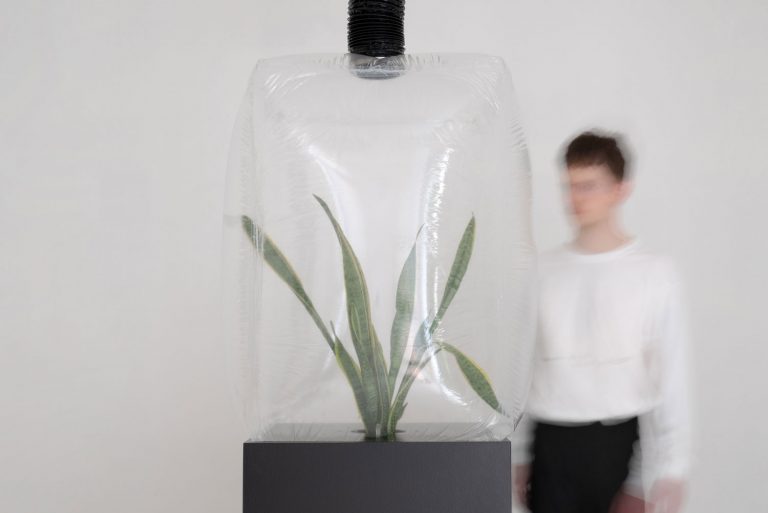
Welcome back to the ESC exhibition! We’re thrilled to present wave #2033, the result of the ESC challenge ( → ), where artists from around the world united to ask thought-provoking questions and shed light on the future of technology and nature. The ESC exhibition delves into the intersection between technology, art, nature, and humanity, exploring how art and technology can raise awareness about environmental issues, challenge traditional concepts of humanity, and open new avenues for exploration and understanding of our place in the world.
This year, 0→1 collaborated with De:Formal (by Vincent Cy Chen and Wednesday Kim). We are proud to have had 304 artistic souls join us this year, and we can’t wait for you to explore the exhibition of the future. Our selected artists posed thought-provoking questions such as the significance of the relationship between technology, art, and human consciousness, the role of art in raising awareness about environmental issues, and the implications of technology’s intersection with the natural world.
Here are some of the artist’s questions: What would the world look like if everyone had access to quality education and healthcare? Are we too reliant on technology as a society, and what are the consequences of this dependence? Can true equality ever be achieved, or will inherent biases and inequalities always exist? How can we balance individual freedom with the greater good of society, and where should we draw the line? Is the pursuit of wealth and material possessions ultimately fulfilling, or is there something more important that we should strive for? How do we reconcile our desire for progress and innovation with the potential negative impacts on the environment and future generations?
Stay tuned for more future visions and collaborations, as ESC will return in the summer. In the meantime, please check out works carefully selected by 0→1 De:Formal below.
Thank you for joining us and shaping the future with us!
Dagmar Schürrer is an Austrian new media artist based in Berlin, Germany. She creates intricate video sound montages by assembling digitally generated objects and animations, text, and sound. Schürrer’s artistic practice involves combining new technologies, such as augmented reality, with her art to create installations and animations.
‘In Dreaming is the mind left to itself’ is a digital animation that examines the similarities between different states of consciousness, including waking reality, the digital realm, the dream world, drug-induced conditions, and spiritual meditations. This work explores how new technologies, such as extended realities and artificial intelligence, can be used to access and reveal these different constructions of reality.
The work is inspired by the theory of ‘The Overfitted Brain Hypothesis’ (OBH), which compares dreaming to a certain aspect of Artificial Intelligence (AI). OBH argues that dreaming works as a noise injection, similar to AI, to help the brain cope with self-repeating patterns during the waking world. The AR video installation takes the viewer through abstract dreamscapes and digital environments, with imagery that becomes increasingly distorted, suggesting the dissolution of parallel realities.
The work’s main theme is the feedback loop between human consciousness and new technologies. It offers a poetic interpretation of how we interact and how we are entangled.

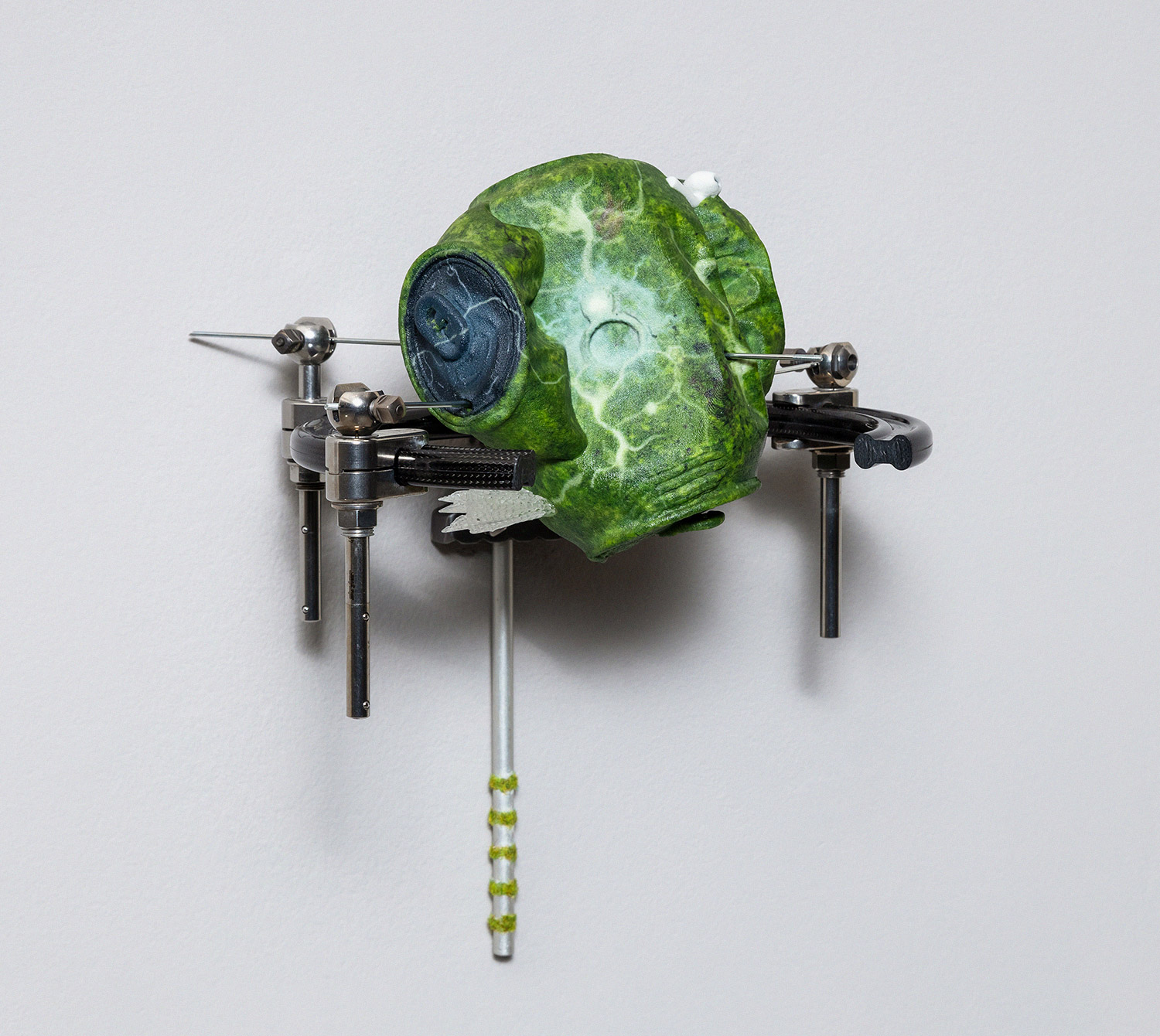
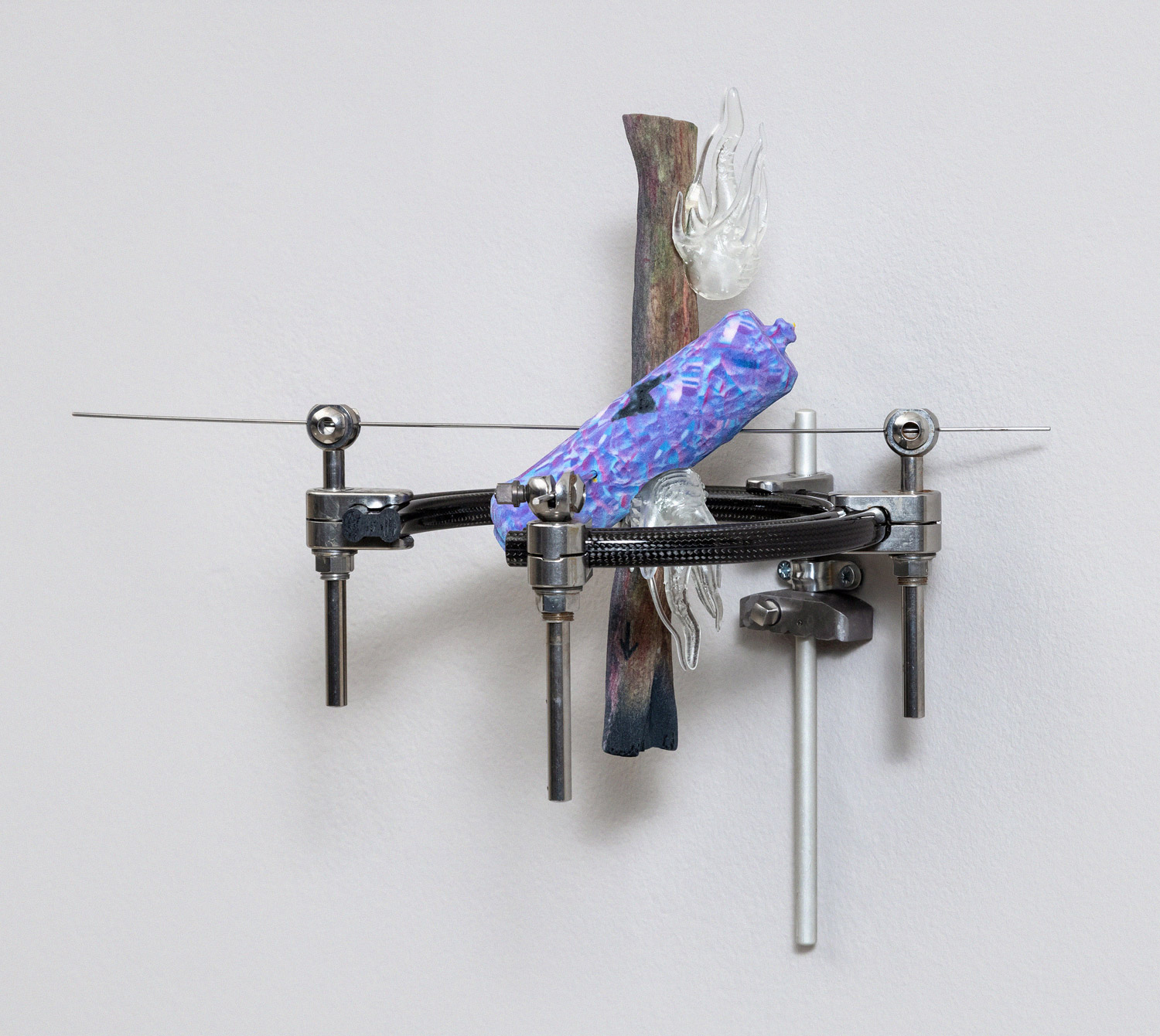
Yorgos Papafigos is a multidisciplinary artist based in Athens, Greece. His practice explores the impact of AI infrastructures on the environment through idiosyncratic fossils that allude to both waste and reconstruction devices. His work includes the use of wound-healing exoskeletons and raises questions about the potential for successful remediation of environmental damage through technology.
One of Papafigos’ recent works is ‘BOLIASMA II’ (commissioned by the Hellenic Ministry of Culture and Sports and exhibition produced by VEKTOR Athens). The work introduces three unique personal sculptural devices that address the impact of intelligent systems on the environment. These objects are assembled using industrial toxic materials, organic matter, and electronic waste, along with medical instruments used for healing.
The sculptures resemble contemporary grafting (boliasma) devices with an eerie aesthetic that could generate new forms of energy or end up being remains of materials with different decay times affecting the environment.
The ‘BOLIASMA II’ sculptures comment on humans’ constant effort to restore their relationship with the environment through new technological inventions and interventions. They are made from fragments of the culture of connectivity, serving as a reminder of the potential risks and opportunities of the ever-increasing technological advancements in today’s world.
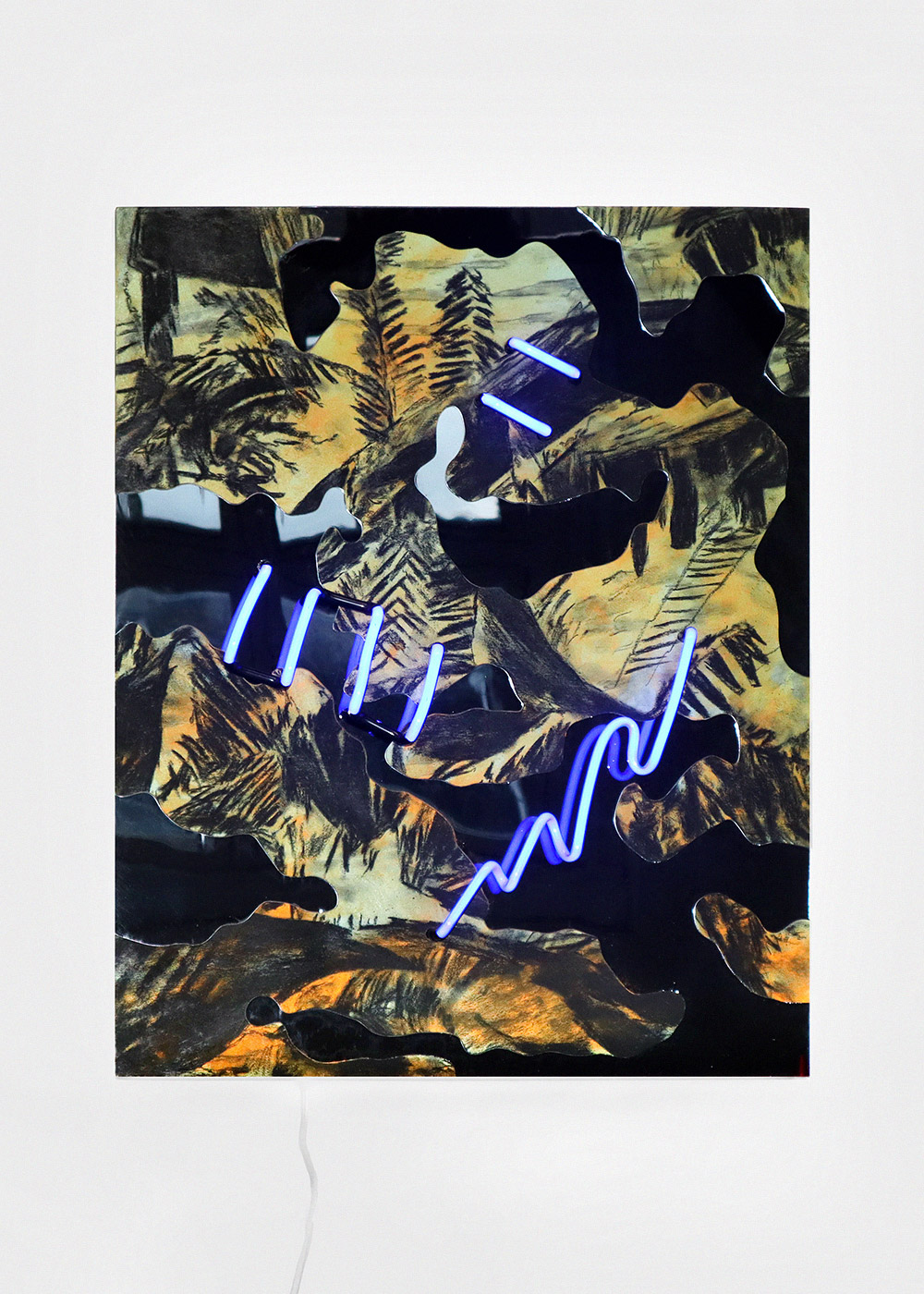
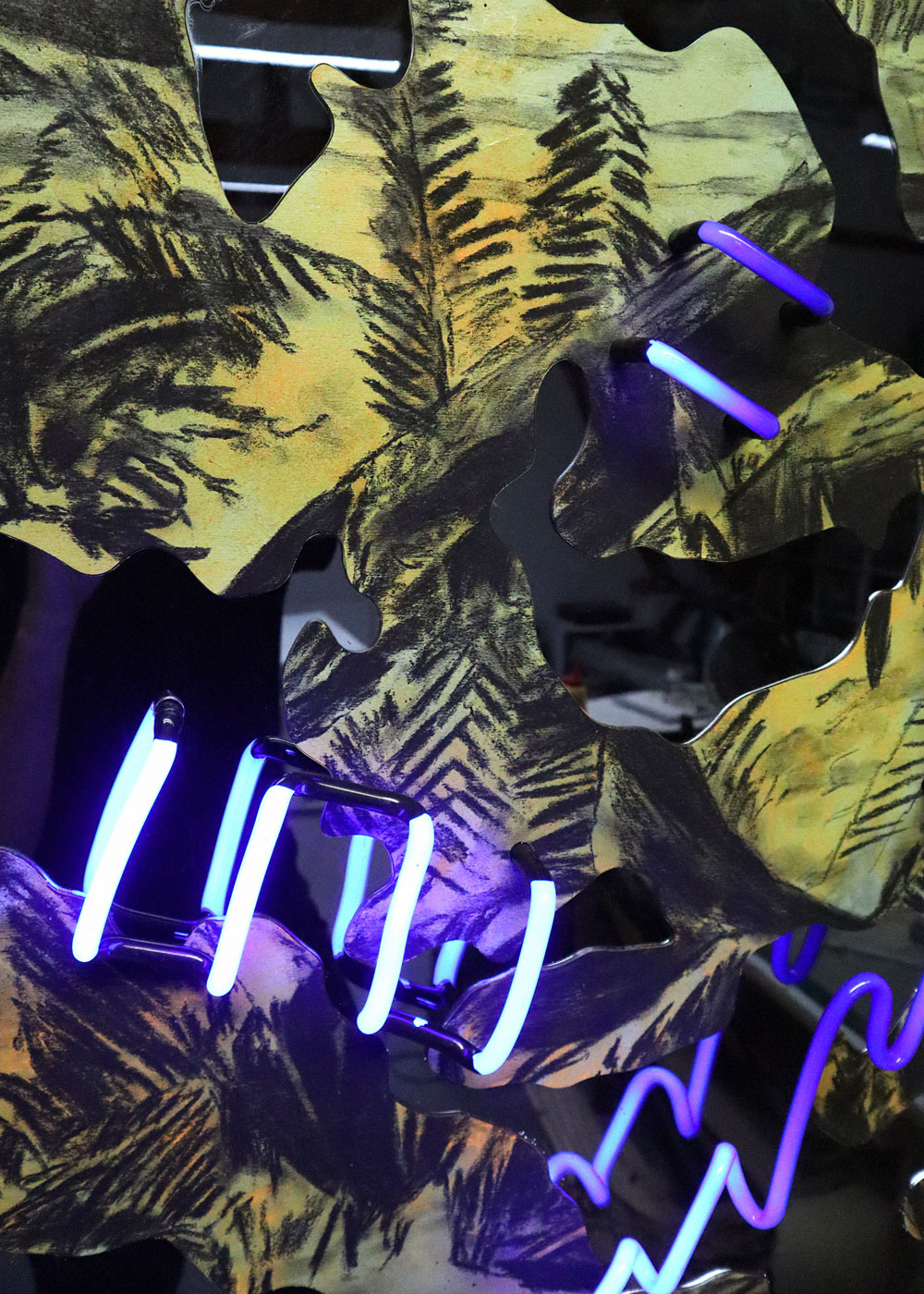
Dutch artist Thijs Zweers creates light installations and detailed drawings based on digital imagery. Through his work, he aims to explore the relationship between individuals and the autonomous nature of the digital world and offer a new perspective on how it intersects with our physical reality.
His artwork, ‘Is This Real Life,’ comprises wood, charcoal, chalk, acrylic glass, and neon. It represents landscapes based on virtual worlds created using a blend of old and modern technology. Thijs Zweers wants to explore and shed light on the ancient philosophical question of the nature of reality and how we perceive it in the future.
Technology is often seen as being in opposition to nature. Still, it is essential to recognize that it is a product of natural processes and materials.
New technology, such as virtual and augmented reality, challenges our perception of reality and the natural world by creating highly realistic digital representations of people and objects. In the future, these technologies can create immersive experiences that can be indistinguishable from physical reality, making it difficult to determine what is ‘real’ and what is not.
The ancient philosophical question of the nature of reality is still relevant today. Plato believed that the world of appearances is constantly changing, and our senses are unreliable. Therefore, we can never know true reality through our senses. He believed that true reality is found in the world of forms, a realm of eternal, unchanging ideas or concepts that are perfect and unchanging, such as justice, beauty, and equality. Plato thought that the things we see and experience in the world of appearances are merely imperfect copies or reflections of these eternal forms.
Shir Handelsman is an artist from Tel Aviv, Israel who draws inspiration from different forms and practices of musical performances. As a former saxophone player, performer, and jazz musician, Handelsman incorporates sound into their films, videos, sculptures, and installations to explore interruptions in human experiences and intimate interactions. By transforming daily situations into orchestrated and musically composed performances, Handelsman creates a sense of disrupted reality that exposes psychological inhibitions and reveals tragic, comic, and absurd moments.
Handelsman’s kinetic sculpture, ‘Stress Fractures’ is composed of raw limestone, wood, hammers, aluminum, and motors. The sculpture features a 200-kg limestone placed on a round podium, surrounded by five hammers attached to small motors. The programmed and motorized mechanism causes each hammer to hit the limestone repetitively every ten seconds, with the rhythm and time of the hits randomly changing in each cycle, constantly forming new dynamic variations of sound and movement.
Despite the constant hits, the sculpture barely damages the object, creating an experiment in time and space focused on the endless and hopeless effort to break the compressed and heavy limestone.
‘Stress Fractures’ highlights the relationship between technology and nature. Taking the stone from its natural habitat and placing it in a gallery or museum already marks the inherent goal of eliminating and destroying it. However, the mechanism created to break the limestone only intensifies and increases the disappointment of its overwhelming failure, rendering the machine powerless. This paradoxical scenario echoes the relationship between man and nature, where man often finds themselves powerless in relation to nature’s forces. Furthermore, the failed mechanical movement that does not succeed in breaking the stone stimulates human movement and echoes the human body and its limitations in certain moments.
Noëlle Turner is a multi-disciplinary artist based in London whose practice spans painting, writing, sculpture, and installation. Her work explores the potential existence of alternate worlds in the present where all matter, organic and inorganic, has a soul. Through these speculations, Turner examines the limitations of binary thinking and the impact they have on our understanding of reality. Her art explores the co-existence of contradictions and how they are necessary for harmony to exist in nature.
Turner’s work also considers the relationship between the spiritual and material worlds and how art can act as a mediator between the two. This ethical dimension of her work is concerned with environmental catastrophe and the necessity of spiritual change to understand our connection to all living matter.
The work ‘Heat’ is an exploration of the character and nature of metal fans and their relationship with oil and geology. Turner uses this work to consider the place of fans within a cosmological understanding of heat, wind, the sun, origin, and rebirth. The fan is a symbol of contradiction, being both sensual and streamlined yet having the potential for violence. The work also reflects on the necessity of fans during the summer months and how we need them to survive.
As part of the ‘Heat’ project, ‘Copter, copter’ features a black resin plinth with three circular pools of water around a carved alabaster stone. A half-heater/half-industrial drum fan above the stone turns on at five-minute intervals, exploring the relationship between the material and spiritual worlds.
Rita Raeva is a multimedia artist whose primary focus is on moving images, CGI, experimental video, and sound. Her works revolve around the body, including the human body, as an object of investigation. She also explores queerness, the boundaries of private and public, and the expression of unrealized desires and traumas through the corporeal, the digitalization of the physical, and the blurred boundaries between the human and the organic virtual.
Her recent project, titled ‘(Introduction to the field of) shapable matter,’ is a speculative work that engages with themes of vulnerability, the large-scale production of ideas and concepts, and hybrid experiences that often remain confined to the virtual field without ever becoming something real. Despite this, they still hold significant agency.
By utilizing the peculiarities of digital image production and its virtual realness, the final product is liberated from the need to be authentic or real. This concept has the potential to raise moral and ethical questions and change the way we think.
The project comprises six objects, each designed to directly or indirectly modify corporeality and deepen the bodily experience. These objects could expand the spectrum of sensory perception but also make the individual more vulnerable to whoever controls these devices. Through her work, Rita Raeva aims to challenge traditional notions of the body and its relationship to technology and virtuality.
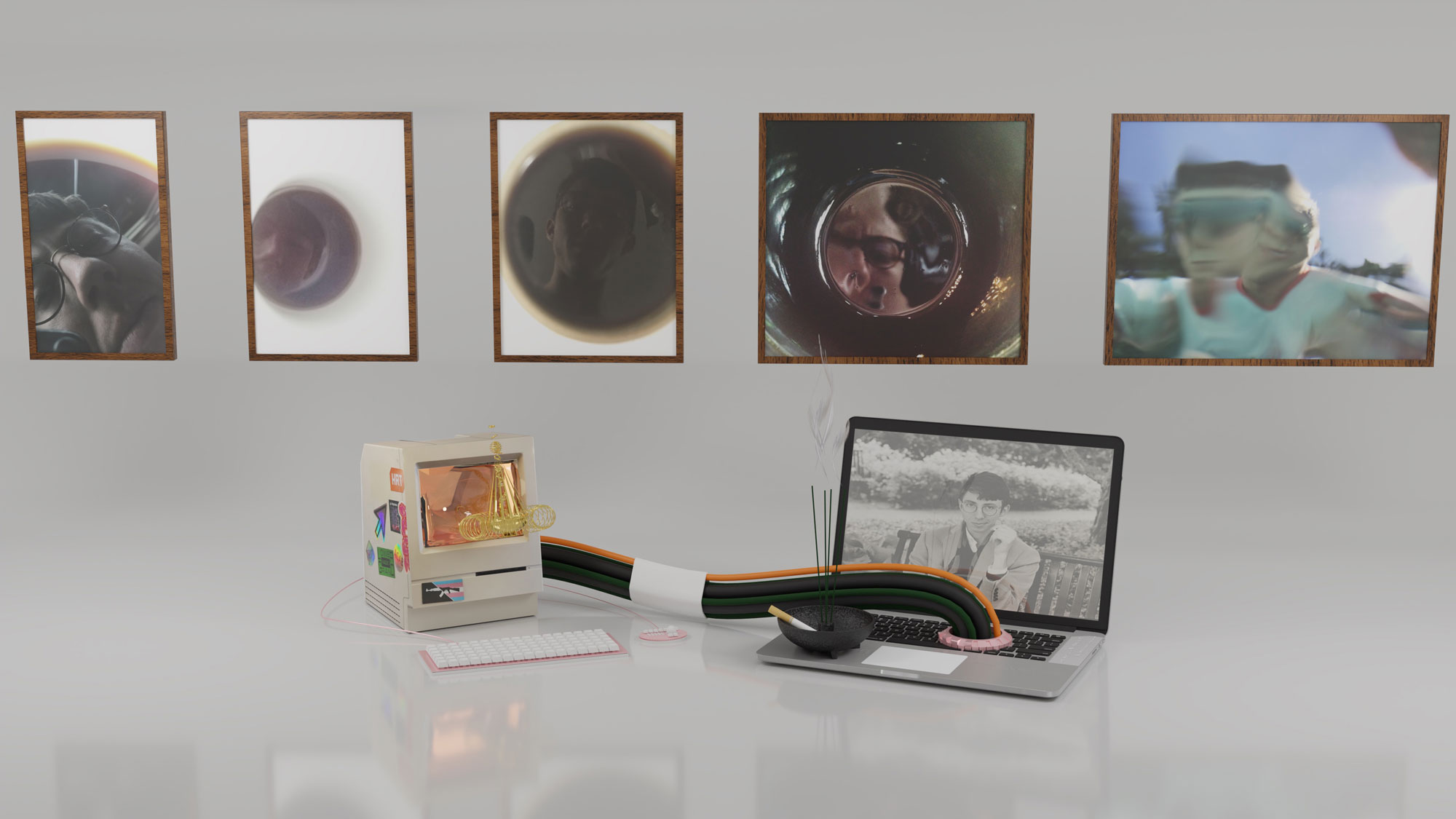
Sammie Veeler is a Los Angeles-based artist who explores the spiritual and transformative power of personal and collective digital archives. Veeler’s art takes the form of undulating loops in time, expressed through performance, digital media, world-building, and prose. Veeler also co-founded New Art City, where they facilitate virtual curation and artist residencies that expand beyond traditional arts institutions.
The work ‘His And Hers Computers’ is a recurring asset in their practice. The work originated from ‘A Time Capsule Or A Grave,’ a hybrid performance project commissioned by the Tezos Foundation for Octobre Numérique Faire Mode in Arles, France (2022). ‘His And Hers Computers’ connects in-person performances with a persistent virtual environment on New Art City that changes with every iteration.
The two computers, featured in the work, are linked by cables and symbolize the digital bond between Sammie Veeler and their late husband, Tvordis. Veeler’s avatar appears on the left, floating out of the screen of a Macintosh, adorned with stickers from their current computer. On the right, a replica of Tvordis’s personal computer, Theseus, displays a portrait of him on the screen.
The work’s central idea is Veeler’s grief ritual and preservation practice with Tvordis’s digital archive. The work challenges the notion that preservation is merely storage and asserts that digital artifacts only perform their objecthood when accessed, always pointing back to an invisible original.
The work encourages viewers to engage with it in their own minds, instead of letting it remain dormant on a hard drive. Audio recordings of each performance are broken into clips and installed in the virtual environment at every place where they were spoken, forming an ever-expanding dialogue between versions of Veeler across time.
‘His And Hers Computers’ challenges viewers to consider the role of humans in the preservation process of digital artifacts, which entrusts the task of storage to a so-called trustless system. It invites viewers to question what preservation means to them and how they can preserve these artifacts. The work is minted, immutably written, and perpetually preserved on the blockchain, with an archival 4K TIFF render, a gLTF 3D file, and a Blend file of the scene included in the edition.
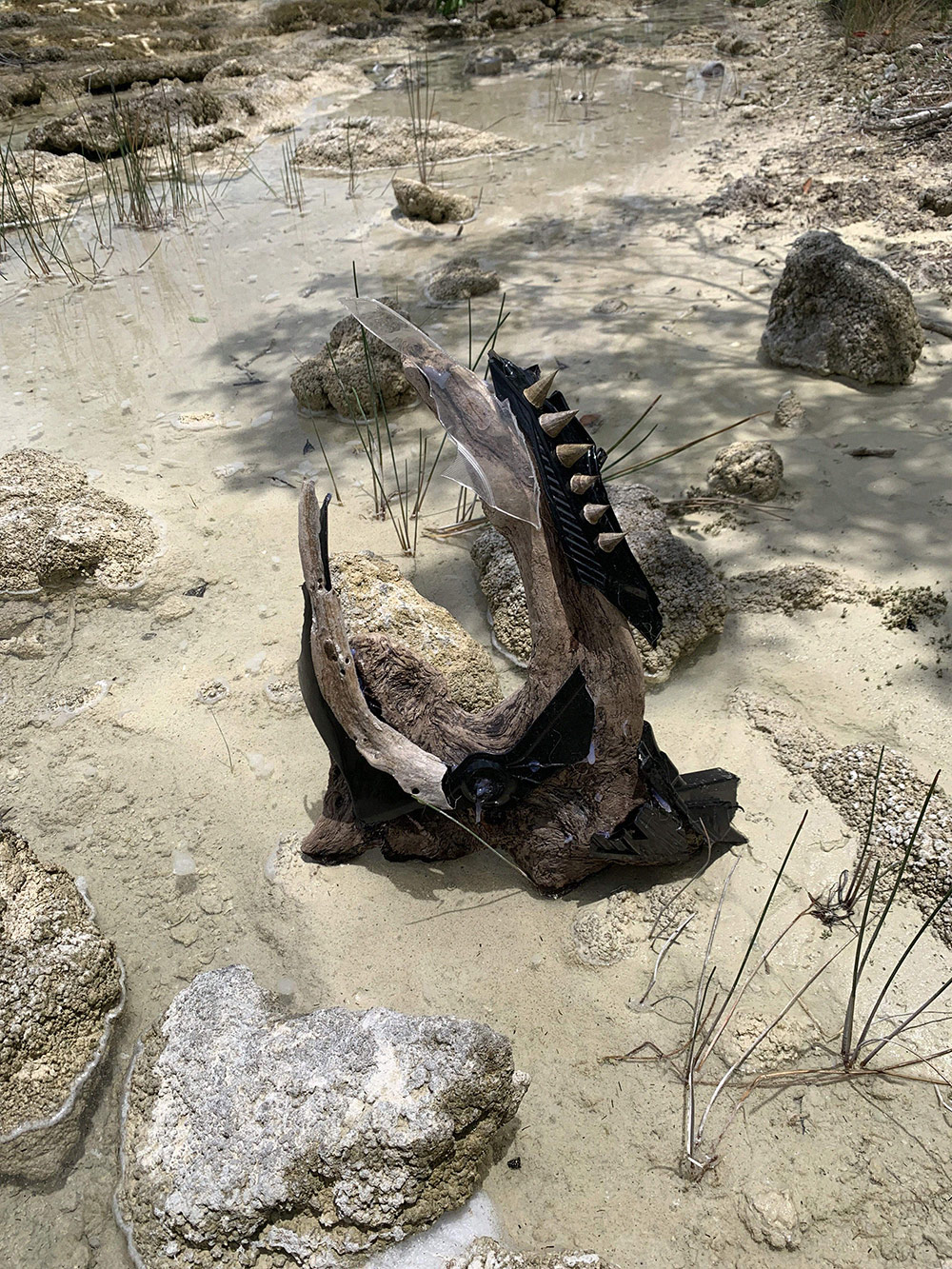
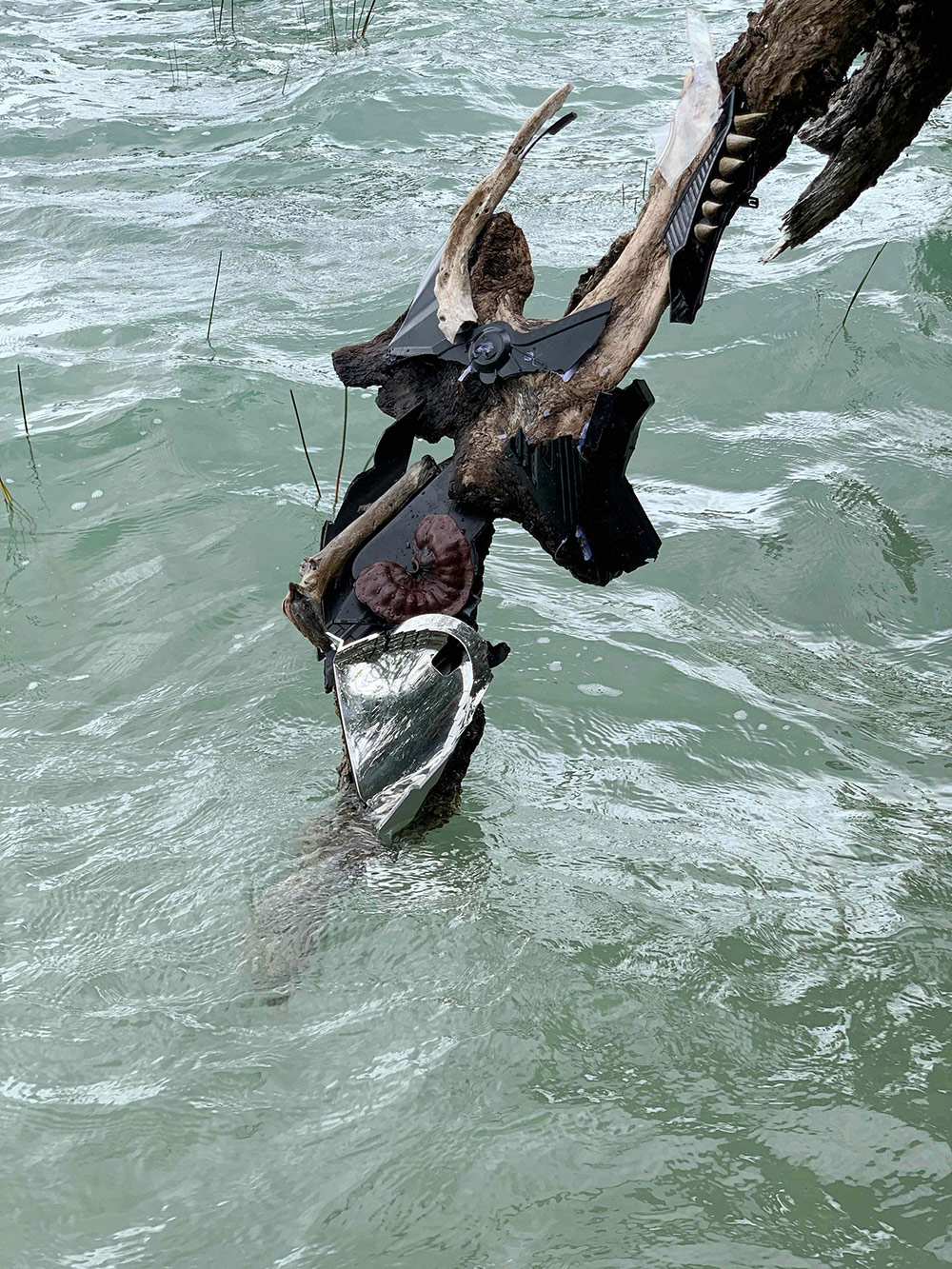
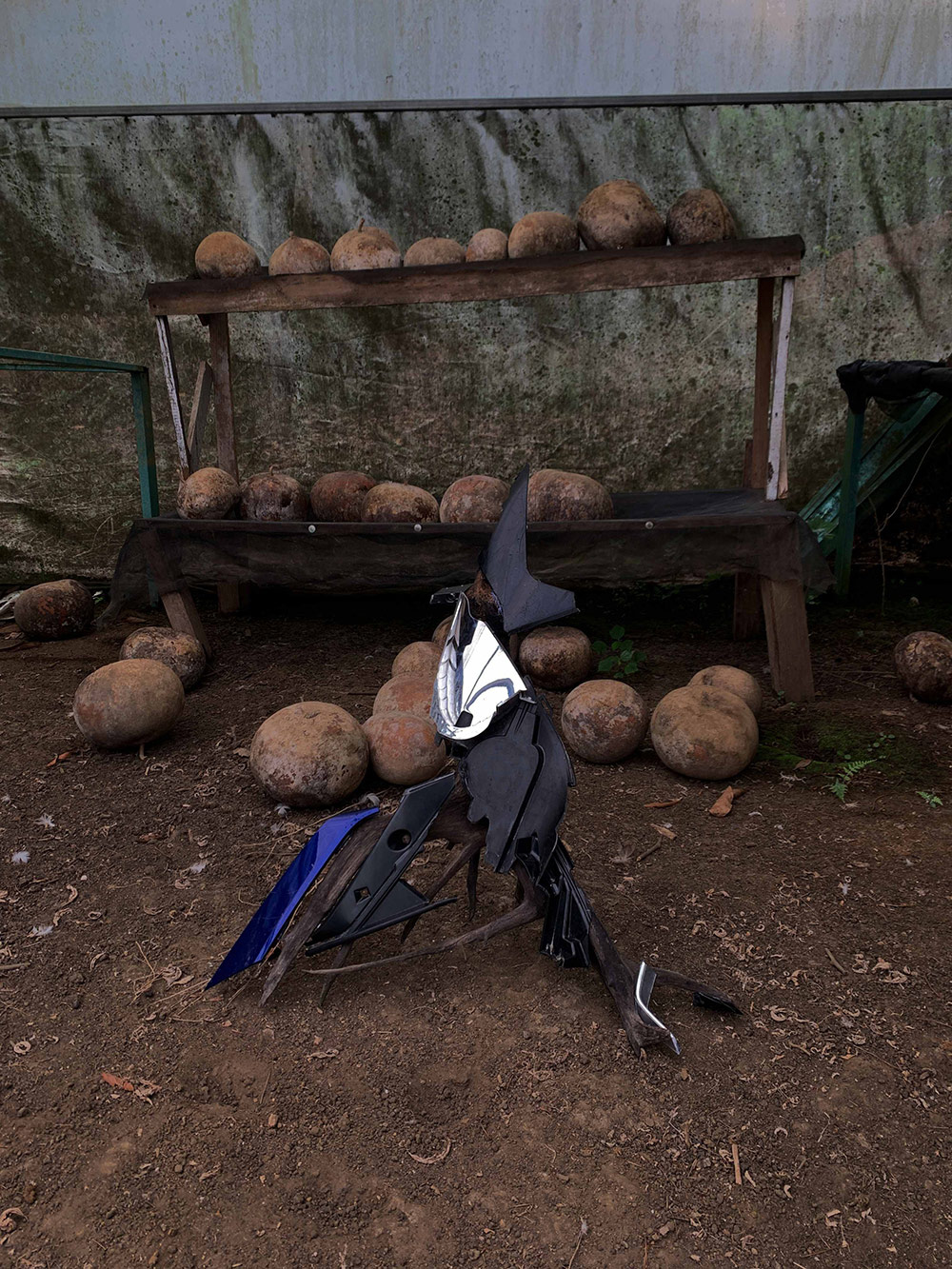
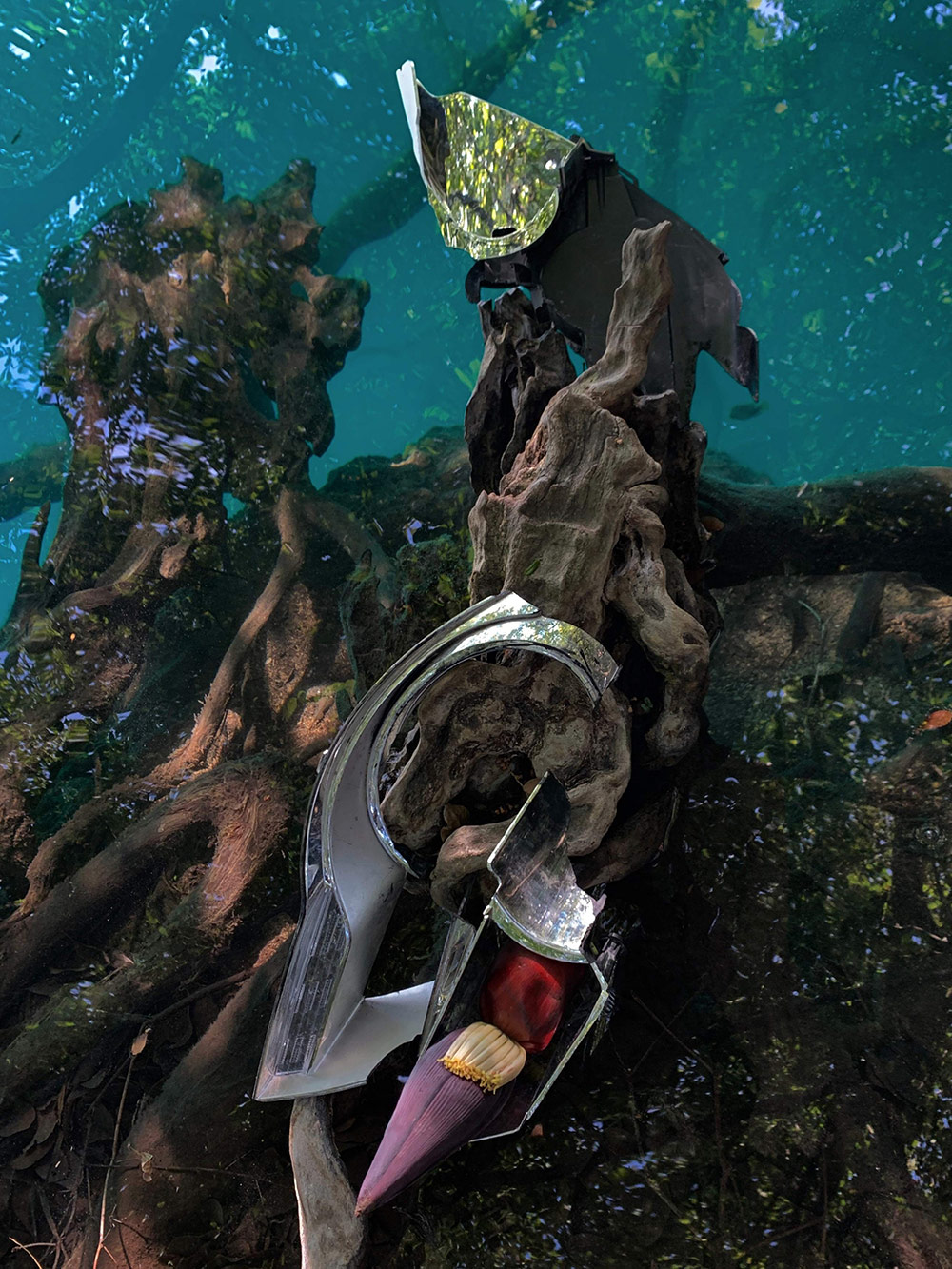
Tinno Circadian is a self-taught artist based in the suburbs of Montevideo, Uruguay. His artistic practice is marked by the use of mixed techniques such as installation, assembly, sculpture, painting, and digital media. He combines different materials and objects from various geographical origins and times to create strange juxtapositions that challenge hierarchical logic and decontextualize spaces. Tinno Circadian’s work is a reflection of our contemporary condition that brings together different temporalities, dimensions, and realities.
The work of Tinno Circadian ‘COEXISTENZ,’ reflects on the coexistence and mutual affectation of biological, technological, and climatic entities in the current context of the environmental crisis. It demands alternative histories to imagine desirable futures for the planet. ‘COEXISTENZ’ brings together found materials from different origins and combines them with different gestures to create subtle and constant metaphors.
Tinno Circadian combines the organic and the inorganic, allowing radically opposed elements to come together until a new xenomorph ology emerges.
Through photography, sculpture, and installation, Tinno Circadian builds scenes that function simultaneously as documents and fiction. During a trip to Mexico in 2022, he collected plastic pieces, likely the result of car crashes and optics found on the sides of the roads. Then he assembled them together with different materials and objects of heterogeneous origin to create ephemeral pieces. These pieces were later documented in different ecosystems, including Stromatolite Formations, Cenotes, Lagoons, and Greenhouses. Tinno Circadian’s work sublimates an anthropocentric vision of the world, shedding human exceptionalism and portraying a myriad of entanglements with our environment.
Smaragda Nitsopoulou is a Greek video artist, film director, and editor who explores the themes of memory and death in the Anthropocene era through her practice. Her interactive pieces feature found footage, aiming to evoke a universal experience of death among the living. Nitsopoulou’s works have been showcased at several international festivals and art fairs, including Documenta 14, Video Art Miden & Simultan. In 2021, she completed her first feature-length documentary, ‘Death Under Control.’
‘I’ve always wanted to see a martian’ is a film by Nitsopoulou that tells a simple story about an astronaut who becomes stranded on a foreign planet. Initially afraid, the astronaut’s fear transforms into an insatiable need to experience the new planet through all of her senses. Throughout the film, we witness the astronaut grappling with the desire to conquer and surrender, exploring themes of identity, labor, exploration, and humanity. The film ultimately offers a sensorial exploration and a revisit of the corporal state that defines us. As Nitsopoulou explains, in the future, art will continue to explore identity and belonging, but through the lens of intergalactic environments.
Mateusz Dworczyk is a German artist who is known for his exploration of photography and photo-based imaging processes. His multimedia works transcend the boundaries of photography and aim to impact social discourses, cultural conditions, and political realities. He brings a media studies perspective with a philosophical focus into his work, based on his academic background. His works often deal with contemporary phenomena and dynamics in socio-technical networks, such as memes and viral diffusion, and the use of new technologies, such as machine learning.
In his work titled ‘Body Options II,’ Dworczyk explores the interplay between technology, the human body, and its visual representation. The focus of the work lies particularly on photo-based digital imaging techniques, such as machine learning and 3D technology. The work is built on the subset of results of an AI trained on a self-created dataset of ballet dancers, which contains outcomes that are usually defined as errors. Those ‘errors’ are then translated into 3D space using 3D software. The images of these sculpted bodies appear in competition with normative body representations and the subjective body images of the visitors themselves, infesting the exhibition space and affecting the viewer.
The work shows the power and impact of immaterial trans-classical machines like AI and reminds us that technical instruments, apparatuses, and systems have always had anthropological relevance and a considerable influence on the idea of the human body, its function, form, and image. ‘Body Options’ opens up a space of imagination that oscillates between present possibilities and future scenarios.
Dworczyk’s aim is to question the functional logic of technology transferred to the body and to visually oppose the inherent tendencies of standardization, optimization, and utilitarianism. The process of translating 2D AI images into a 3D figure anticipates a further stage of development, namely the estimation, analysis, and generation of 3D geometries by means of neural networks. This technology, which is still rather immature and imprecise, is thus experimentally and artistically anticipated in this work. The work does not focus on the fear of technology, but rather on the omnipresent relationship between technology, the human body, and the ever-changing image of the body.
Georgia b. Smith is an artist from New York who creates sculptural environments that are brought to life through performance. She incorporates motors, lights, and sound into her sculptures to make them an extension of the performers’ bodies or enable them to perform on their own. Smith’s projects culminate in films that capture a world where the performers, props, and stage are all equally active participants.
‘Cavernous Bodies’ is a thought-provoking work that explores the blurred lines between human and inhuman agents. Georgia b. Smith probes these uneasy territories by creating relationships that may seem symbiotic but can be confusing. In this work, a human performer moves languidly among biomorphic specimens, which radiate the disconcerting sexiness of a pole dance in a dissection laboratory.
The work features three objects suspended in open space: a set of disembodied silicone lungs, a structure made of a pneumatic system, solenoid valves, and silicone that resembles dead coral with pulsing pustules on a steel examination table, and a steel tree that appears to have grown synthetic lifeforms instead of fruit. The use of metal and plaster creates an industrial and unsettling environment.
The work is urgent in its need to find symbiosis with fellow life forms, especially as new AI technologies diminish the distinctions between life forms and life-like. The work is a haunting reminder of the need to connect with others and other forms of life in a world where technology is blurring the lines between what is human and what is not. Georgia b. Smith’s use of unconventional materials adds to the eerie and thought-provoking nature of the work.
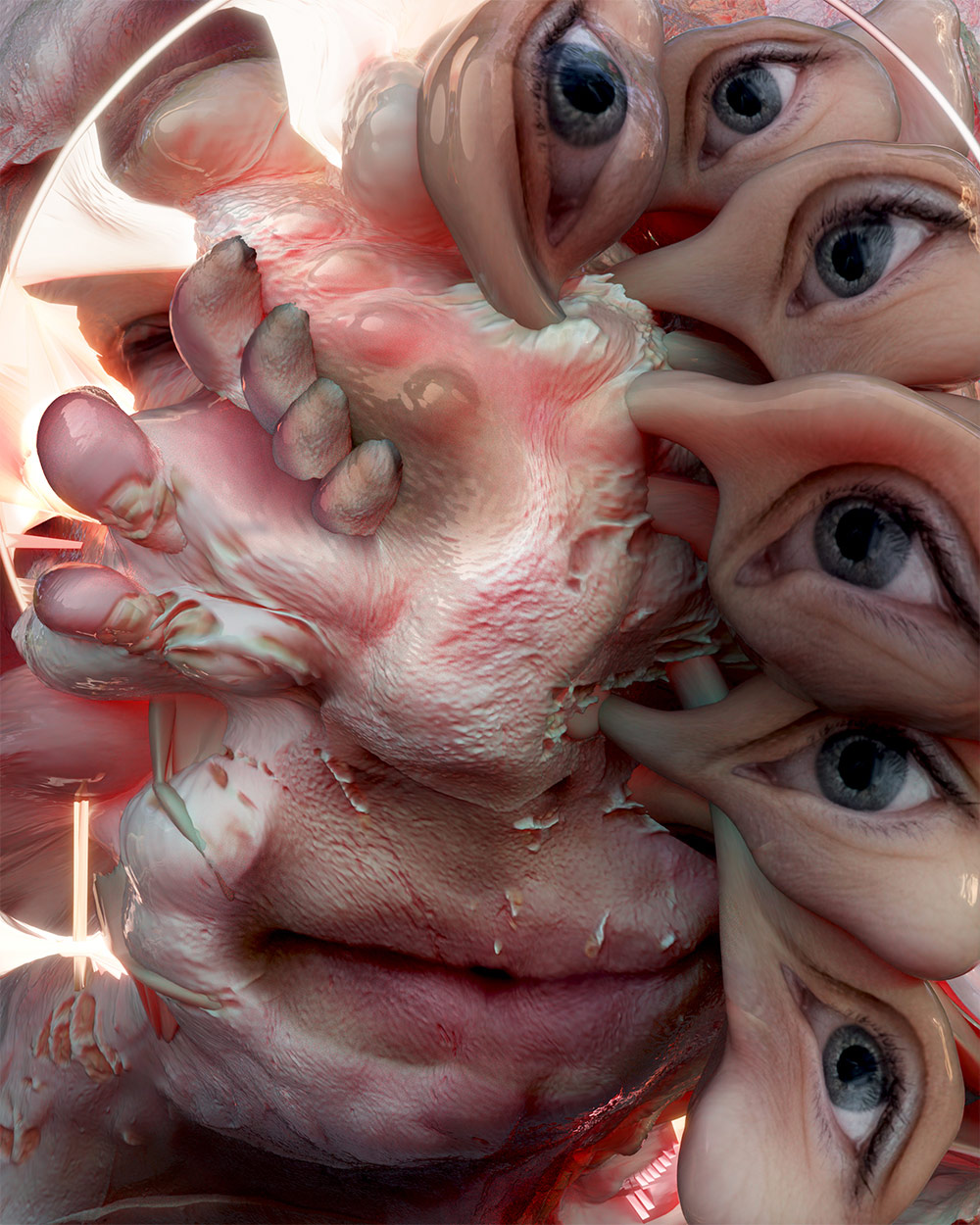
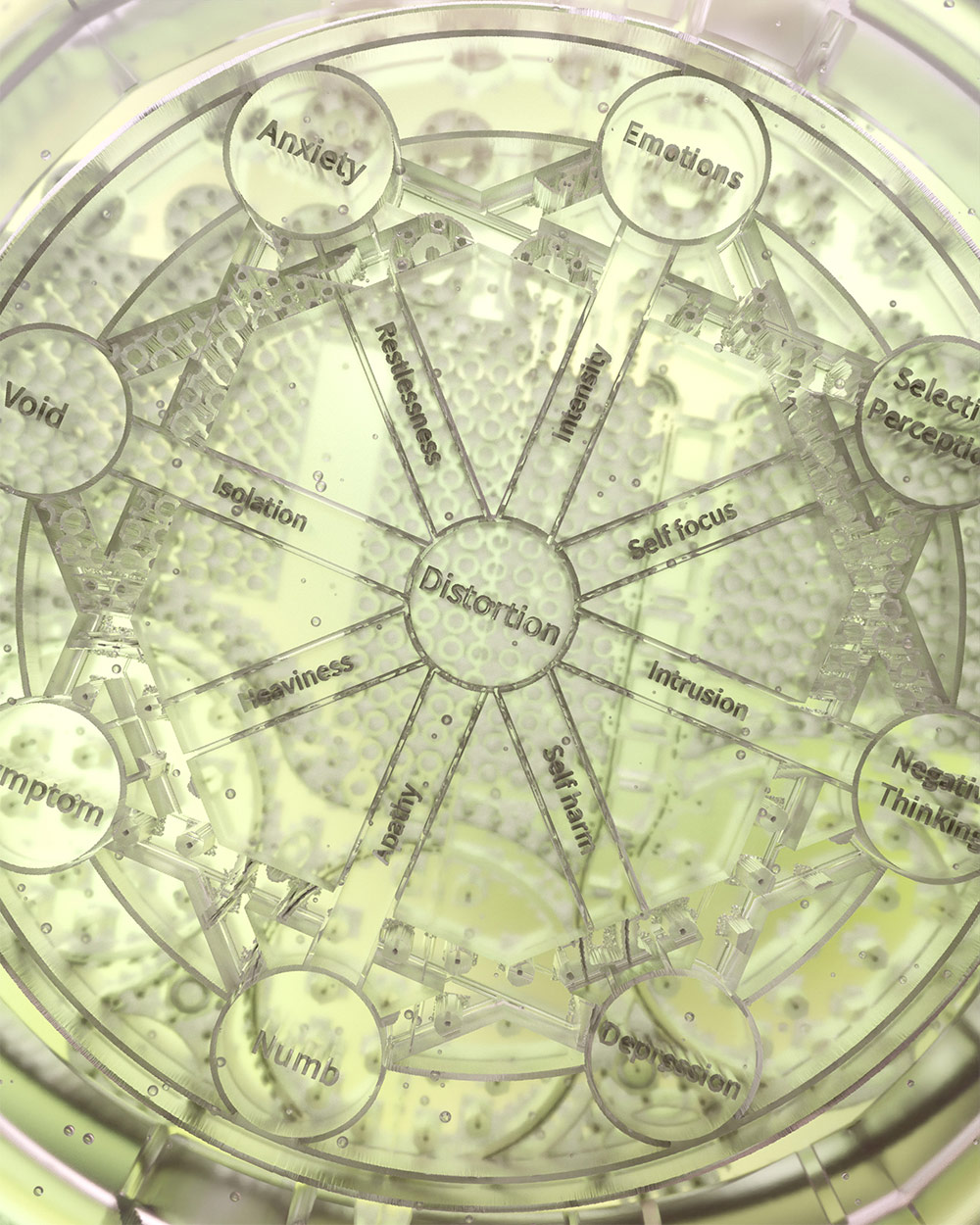
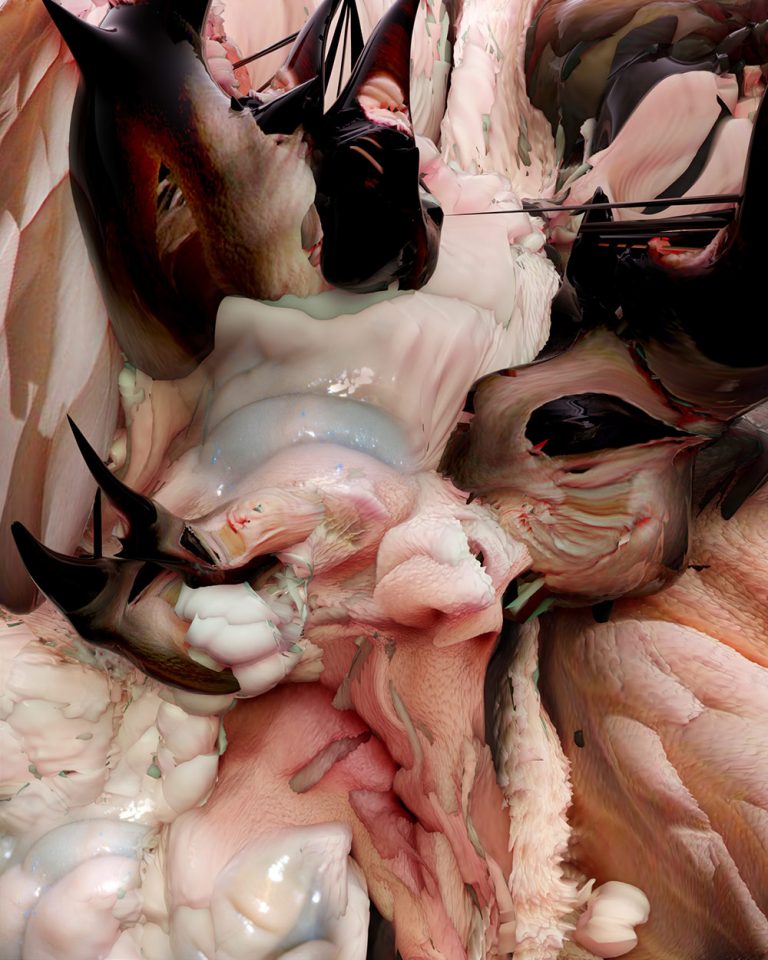
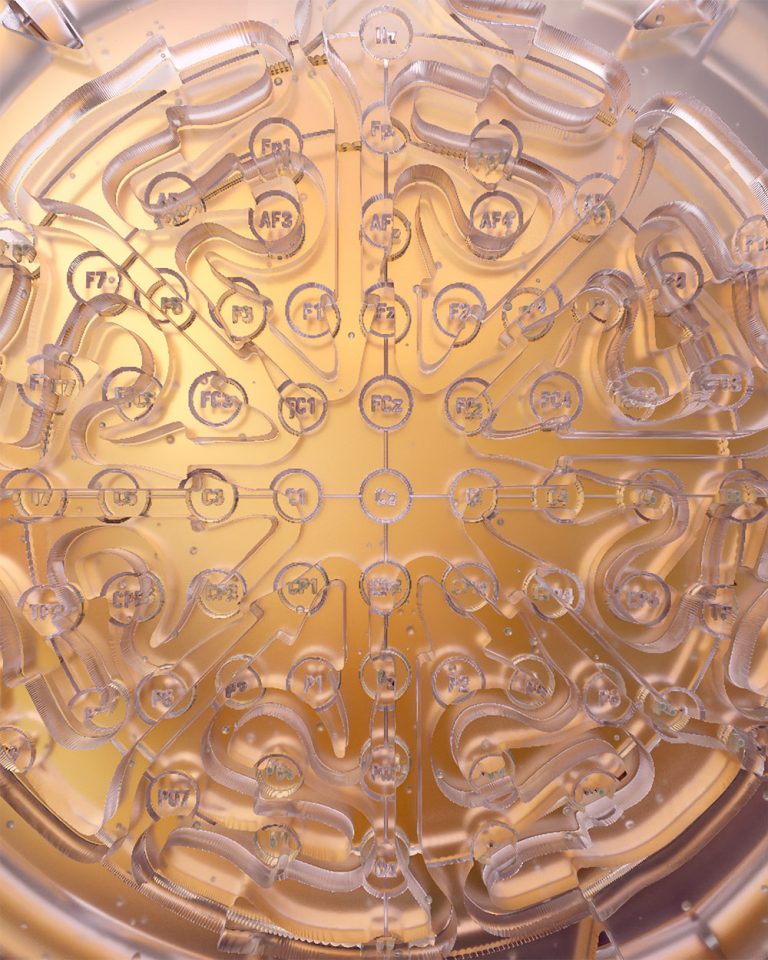
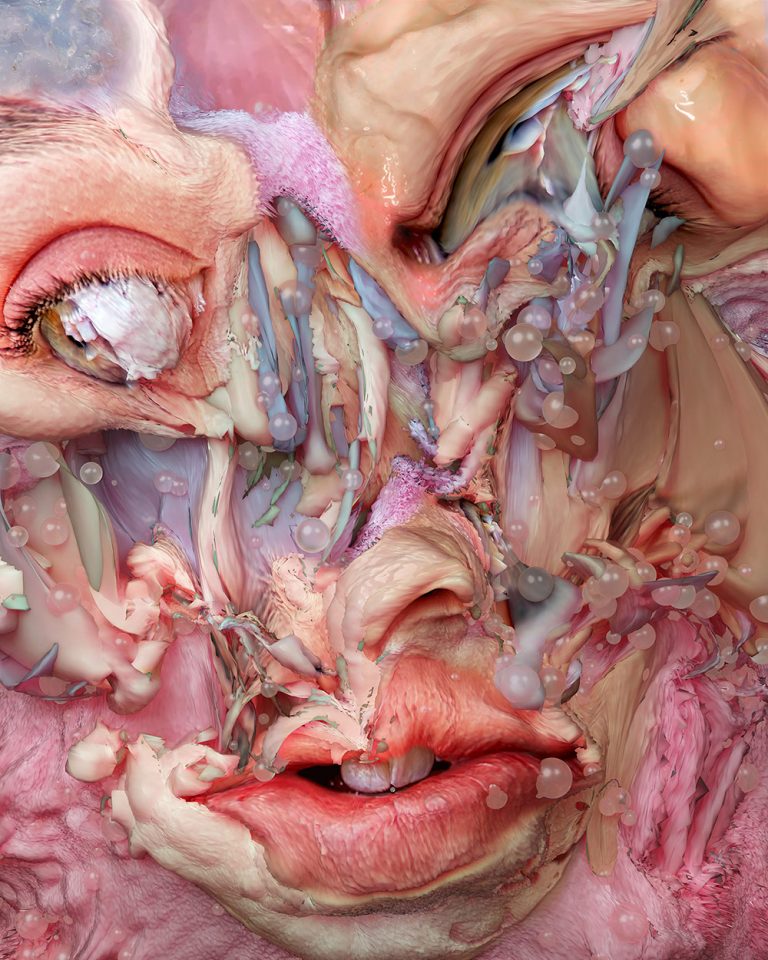
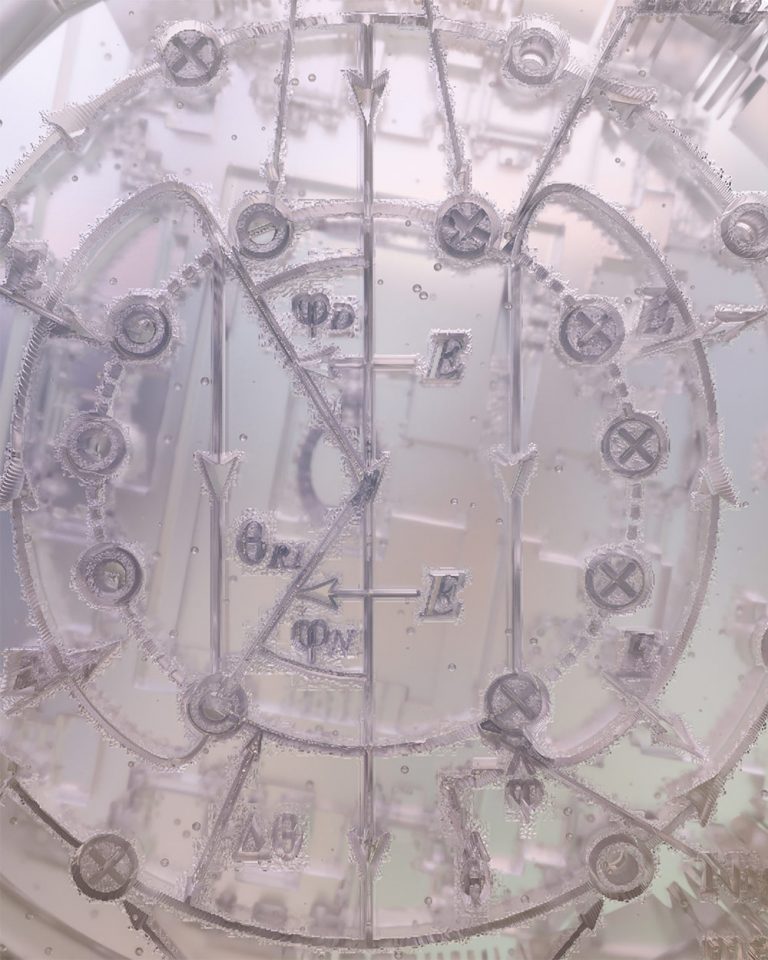
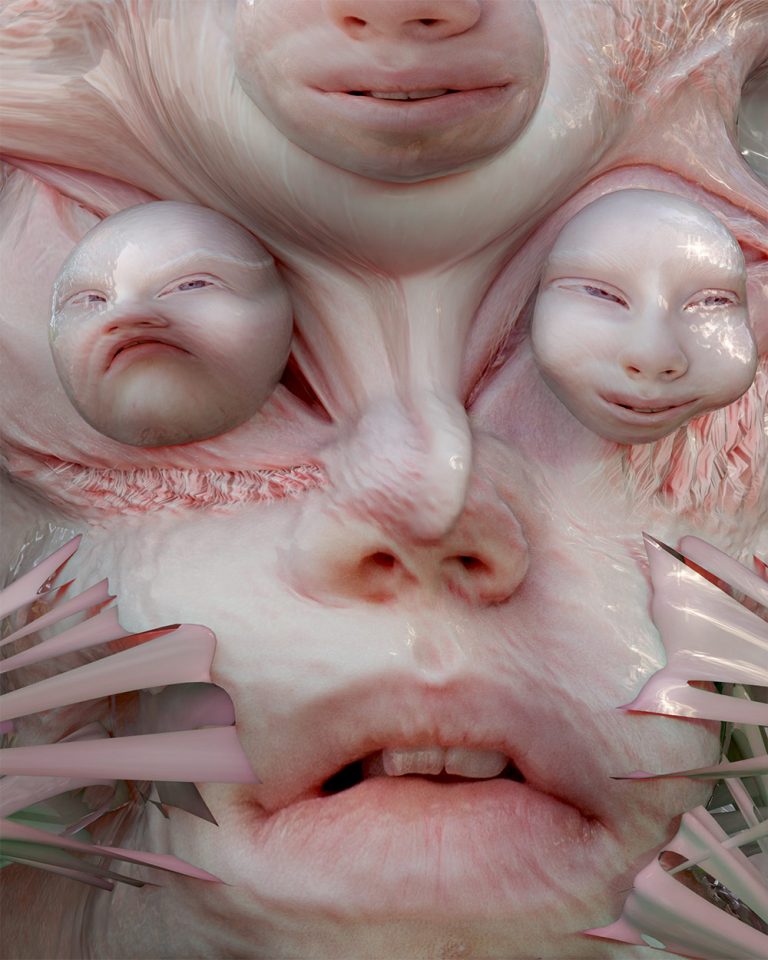
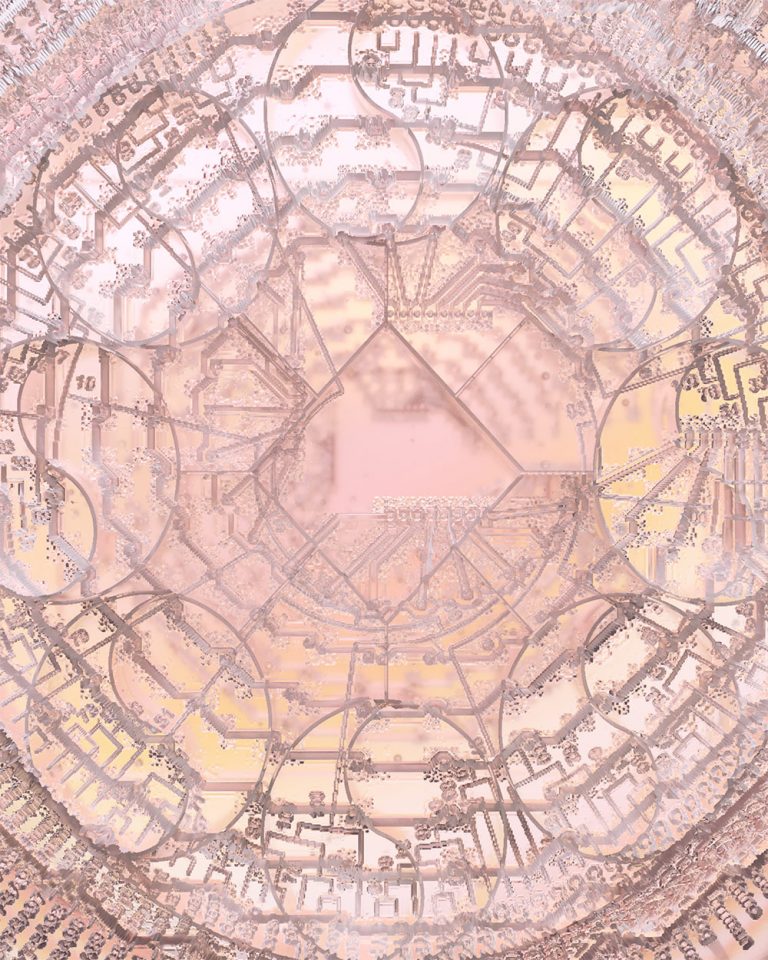
Romain Thibault is a French artist who is interested in exploring the relationship between technology and mental health. He questions how much of ourselves we pour into our digital devices and how it affects our well-being. Romain’s work is centered around the concept of cognitive distortions, thought patterns that cause individuals to perceive reality inaccurately and negatively. He examines this phenomenon through the lens of our image culture, how it is translated online, and how it impacts our mental health.
In ‘Cognitive Distortions’, Romain uses 3D software to gather and process online found photography, altering and collaging them in the 3D space. He produces distorted avatars and surreal visions revolving around mental health issues, tapping into the absurd, the oneiric, and the nightmarish. These vivid productions often feel like distorted popular culture icons. Romain aims to raise awareness about how algorithms and screen time further damage our mental health.
The work is inspired by Romain’s reflection on the constant mediation of our lives by digital interfaces. He questions whether machines can understand and share complex emotions, not just simulate them. He wonders if we can connect in the realm of our dreams and record them. Could a machine understand our traumas and help us get passed them? Could it decipher the symbology of our subconscious, leading us to better and clearer communication with one another and eventually, a healthier future?
Romain’s work is a reflection of his emotional landscape and his exploration of it, which serves as a tool to educate himself and express his thoughts on mental health. These processed fragments are then sent back to the internet via social media, which has become Romain’s outlet to explore his emotions and take the first steps toward inner well-being.
Sun Ho Lee is a cross-dimensional artist from Seoul/Berlin who focuses on digitized ecosystems and modified bodies while exploring biology, the environment, and post-modern industries. Sun uses different mediums for her art, including VR, videos, 3D printed sculptures, and AI explorations.
Sun’s work titled ‘DAKOTÀ’ is a 23-minute cinematic virtual reality experience set in the year 2055, co-developed with GPT-2. The work explores how the coexistence of humans and non-humans will look in the future. The plot includes a setting where communications between humans and other species are prevalent through simple EEG signal transmissions. However, advanced technologies have caused the physical degeneration of human nature, leading to the concept of ‘human hibernation’ as a successful but aristocratic method for restoration.
The audience experiences the work as the protagonist, who must be the final alpha tester for the software before it is released to the public for free.
The working title ‘DAKOTÀ,’ originally a gender-neutral name of Native American origin, stands for the name of the software service developed from the hypothetical company ‘ghost properties co.’ in the plot. The simulation is led by the AI — Beta, who acts as a friendly guide throughout the plot. The simulation moves from the ‘Departure Port’ to the ‘Hybernest’ (modeled after the spaceship where the sanctum ‘눈’ meaning the ‘eye’ is located) where the full-fledged virtual hibernation takes place, led by Beta’s sister AI named Theta.
Theta attempts to sync the protagonist’s brain frequency by asking questions ranging from daily lives to macro-societal events while inducing brain and organ recovery. During the hibernation process in ‘눈,’ a critical issue arises due to the wrong synchronization between the protagonist’s memories and the ‘DAKOTÀ’ database, leading the audience to a new dimension. Here, the audience is introduced to Delta, who calls herself a child of Alpha and explains the crash caused by the wrong synchronization of each.
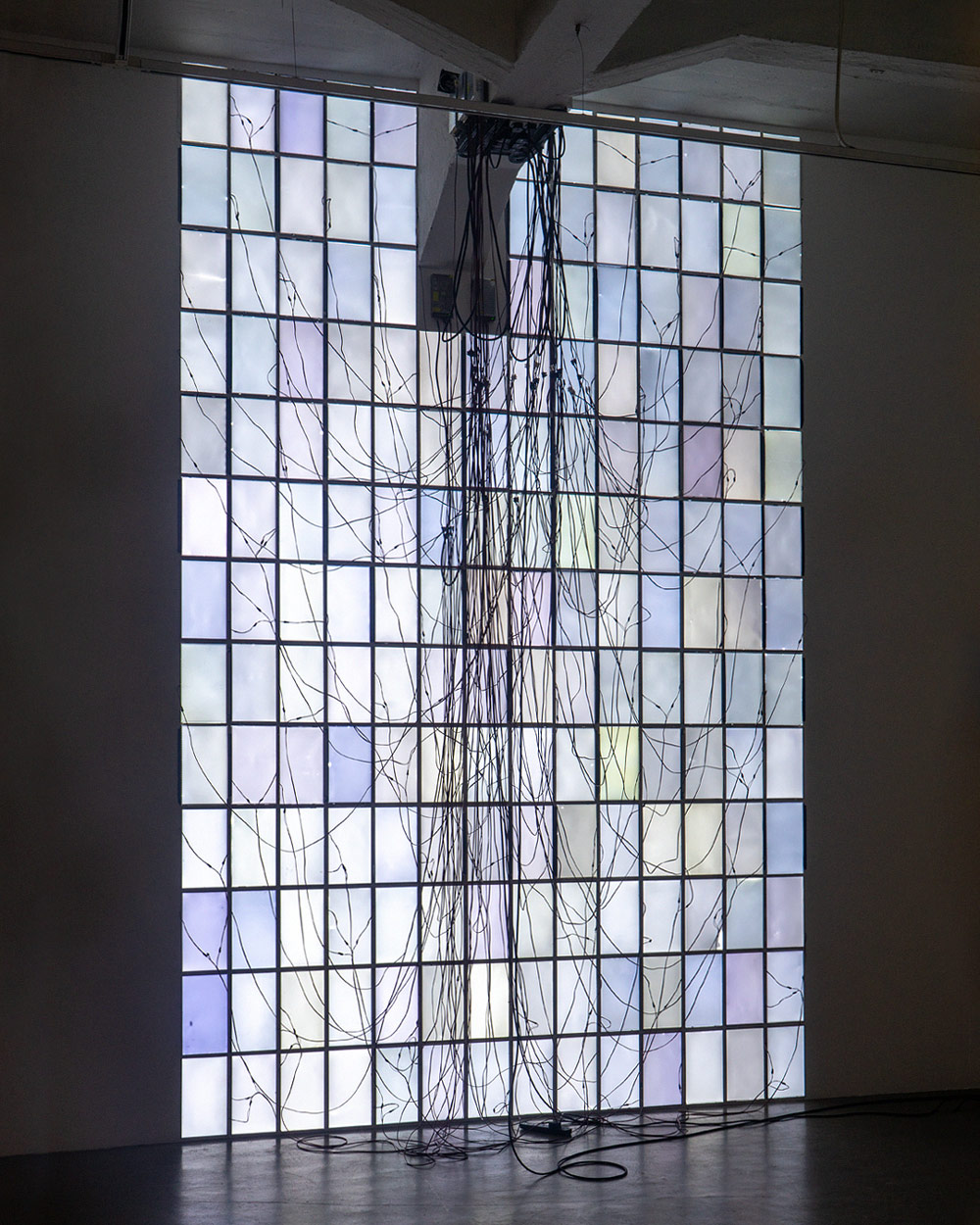
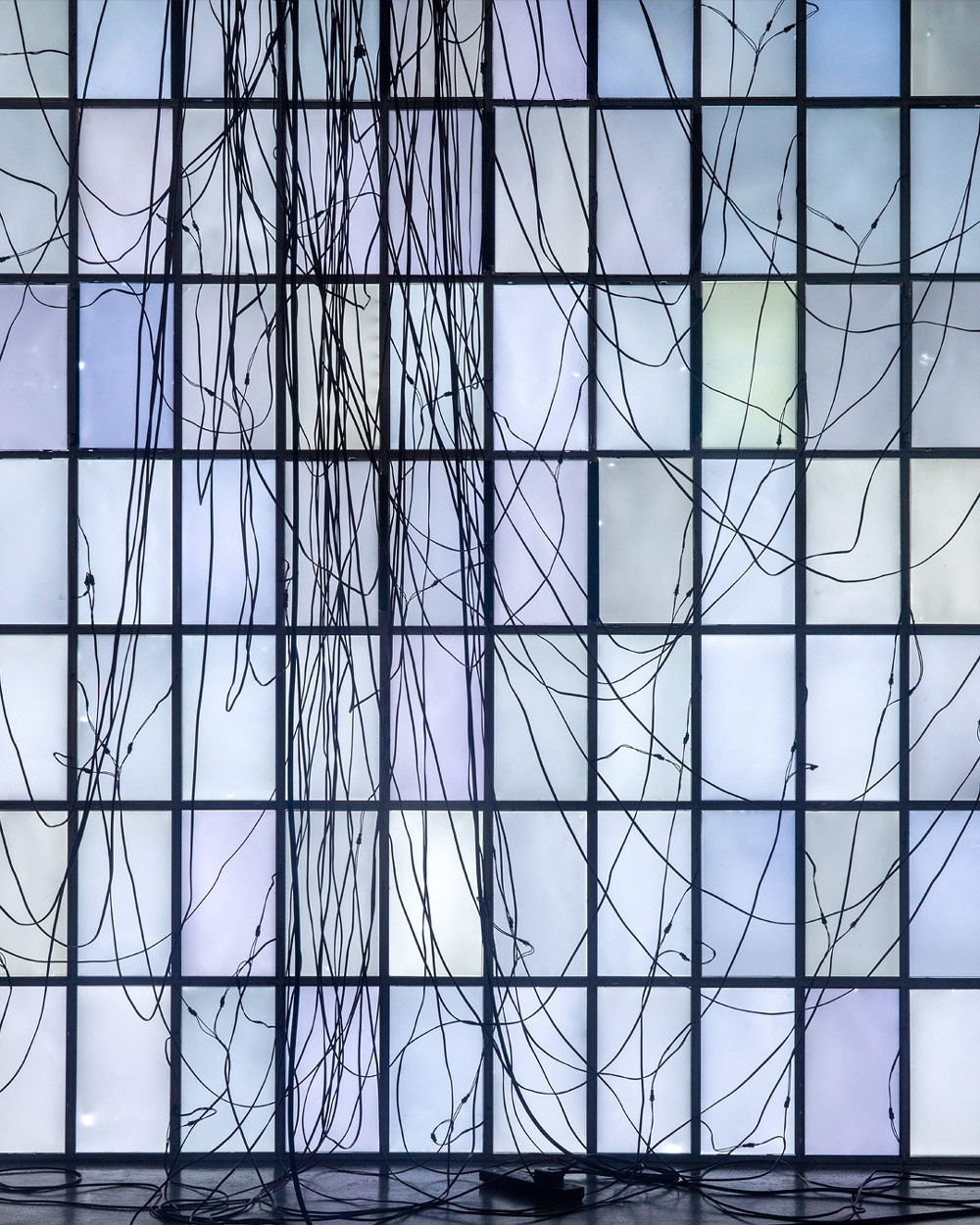
Katrin Hanusch is a multidisciplinary artist from Germany, who is currently based in London. Her artistic practice encompasses a wide range of media, including performance, sculpture, installation, and drawing. Hanusch’s works are site-responsive and explore the interconnectedness between humans and the environment.
The artist’s practice is characterized by an experimental approach to materials. She works with a diverse range of objects, detritus, and discarded by-products of processes. Hanusch’s practice is intuitive and poetic, and she transforms materials into actants that propose new potentials and future materials.
Her work ‘The Gate’ is part of a series of light works and installations. The work consists of modified LED laptop screens, cables, extension leads, power supplies, and nails.
The installation emanates a wall of light that displays a gridded palette of fluctuating violet tones. The glowing structure exposes its own inner networks of wires and cables, radiating from it like the nervous system of a body. The work is modular in nature and continually adapts to various sites, conditions, and performative contexts. Hanusch created the series from discarded laptop screens, whose inner back-lit panels have been re-instated. The screens are reminiscent of advertising billboards, but they do not transmit any information. Instead, they emit a translucent aura that bathes viewers in subtle light.
Each iteration of the work touches on the layered thoughts that inform it, such as the consumption of dwindling earthly resources, waste culture, and cycles of life. The screen components are re-imagined through ownership by will, chronicling radical shifts in value.
Alek (Aleksandra) Sarna, a simulation artist from Warsaw, Poland, is known for creating site-specific virtual worlds and performances using VR/gaming technology. She often makes speculative CGI films, which are showcased as multimedia installations combining physical elements. Sarna studies the spaces between reality, 2D, and virtual 3D representations. Her visual narratives are built on the basis of subjective perception, organization, and interpretation of personal impressions in order to understand the surroundings in an era where nature, humanity, and technology overlap.
One of Sarna’s works, ‘Fälla Snara — Dom Depot 2.0,’ is a reinterpretation of Anna Uddenberg’s contemporary work, ‘Dom Depot.’
The piece is based on the redesigning of Home Depot, a store that may become a monument from the future for those who agree to irregular remote working hours, those who have a so-called ‘text neck,’ those who reluctantly finish Fortnight, those who watch serials on tape, or those who haven’t returned to the office after a pandemic.
The work explores the future that may be waiting just around the corner. Sarna questions how much we can withstand the accelerating, inevitable technological changes that affect our bodies. While human adaptation is not as fast as it might seem, each of us is suffering or will suffer the consequences of uncontrolled development. Sarna imagines what a future could look like in which all human needs are met by high-tech furniture. Although an exciting picture of future possibilities emerges, the question is: what will be the cost?
‘We are delighted to share the challenges in the norms and pose intriguing questions and your responses. And thank you for your inspiring work and for being a part of this exhibition. Your contributions challenge us to see the world explore new perspectives with a powerful impact.
Also shout out to all the artists, thank you for sharing your work with us. Please stay tuned for more upcoming projects from De:Formal. We look forward to the opportunity to showcase your work in the future.’
— Wednesday Kim & Vincent Cy Chen, De:Formal →

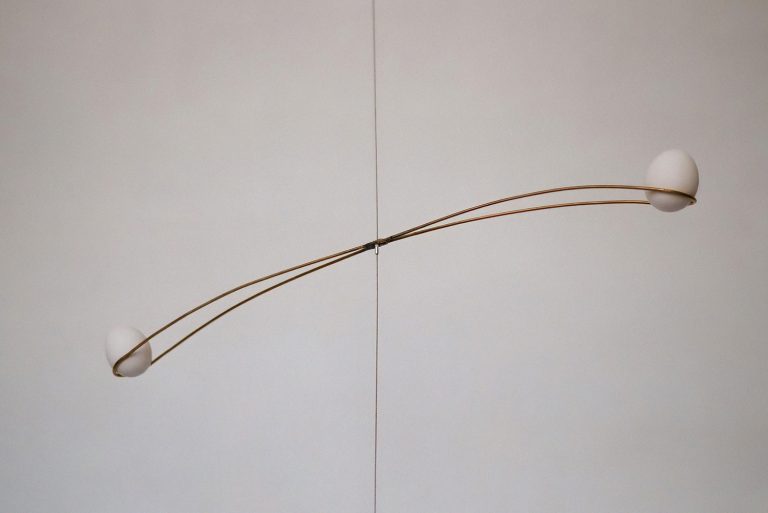
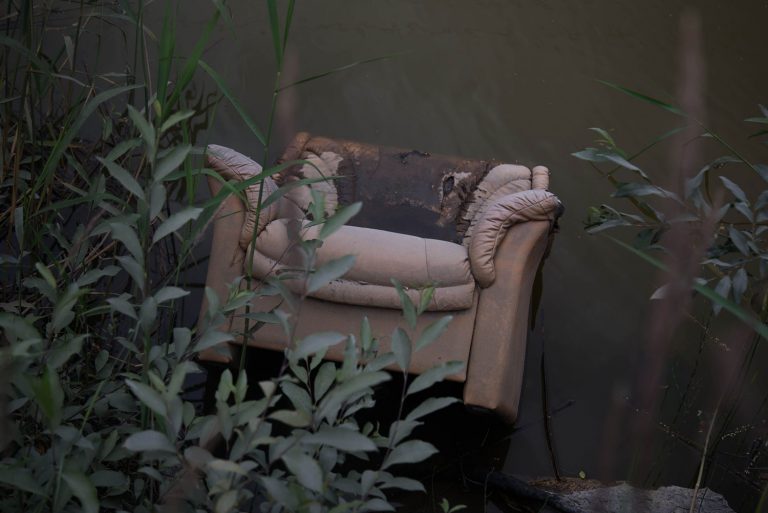
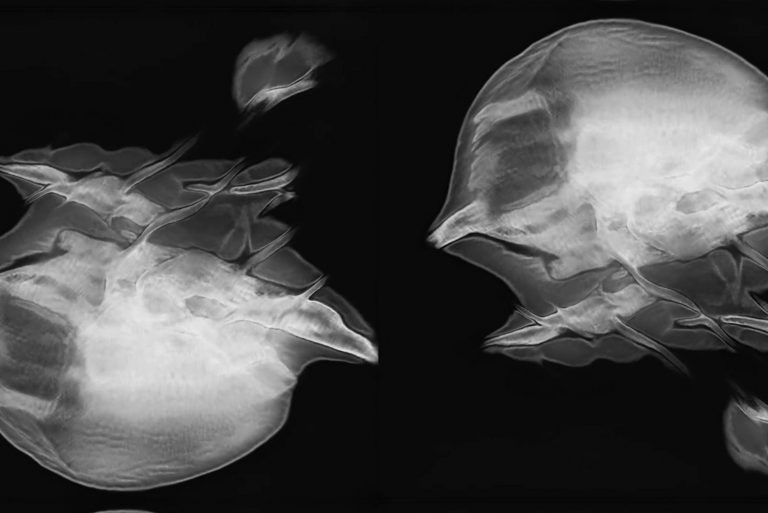
Independent Art & Design Gallery 0→1 © 2024
Stay in the loop with 0→1. Join our email list for the latest news, artist highlights, and first dibs on our exclusive collections. Dive into the art world with us — curated, simplified, and personal.
(We respect your inbox. Our updates are curated for value, and you can unsubscribe anytime. No spam, just art.)
We use cookies to improve your browsing experience; details in our Privacy Policy →